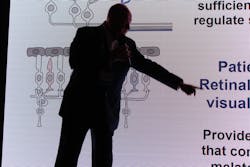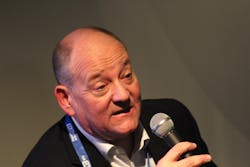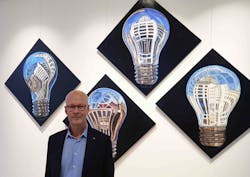Circadian pioneer says we’re not ready for circadian lighting. Does he really mean it? (MAGAZINE)(UPDATED)
Ask circadian science expert Russell Foster to comment on the ways in which LED lighting can buoy human health by mimicking the sun’s spectral patterns, and you’ll get a surprising answer.
“We’re not ready yet,” said Foster, professor of circadian neuroscience at the University of Oxford. “We’re shuffling closely toward it, but there are major questions that remain unresolved. Yes, the toolkit is better than anything we’ve had before, but it is not the complete answer yet. We haven’t got the data to plug in.”
This is hardly what you’d expect from someone who, in the 1990s, posited the notion that certain cells in the eye’s retina receive light that has nothing to do with processing vision but has everything to do with maintaining the circadian rhythm.
Foster’s pioneering, decadelong hunch proved correct in 2002 when Brown University professor David Berson uncovered nonvisual photoreceptors, known as photosensitive retinal ganglion cells (pRGCs). Foster himself also found them soon thereafter.
Whereas the retina’s rods and cones send signals that the brain translates into visual images, pRGCs communicate with the brain’s master clock — or, technically speaking, with its suprachiasmatic nuclei (pRGCs are also known as ipRGCs, or “intrinsically” pRGCs).
The master clock coordinates billions of circadian clocks that reside in cells throughout our organs and tissues. In humans, it runs on a cycle that averages 24 hours and 15 minutes. As Foster’s work has shown, light is crucial to resetting this internal clock on a daily basis, thus keeping humans on a 24-hour cycle. Light’s vital role in pacing the human physiological process is time honored, to say the least.
Mess with that light-centric, 24-hour rhythm, and you’re asking for trouble. Unbalanced circadian durations have been linked to all manner of physical and mental maladies, from diabetes to poor sleep, cancer, and neurological disorders. And yet messing with it is what we potentially do every day and night that we subject ourselves to electric lighting or fail to go outdoors and receive a healthy dose of daylight to instigate circadian entrainment.
LEDs to the rescue
The LED lighting industry has been developing systems that tune indoor light to emulate the daily pattern of sunlight, both in brightness and spectral content. (See a commercial example on our cover with Cree Lighting’s Cadiant dynamic skylight).The digital nature of LEDs makes the technology ideal for circadian, or human-centric, lighting systems.
LEDs Magazine wrote about early trials and ideas in human-centric lighting back in 2016, predicting that commercial implementations would be slow to develop. A year later, the concept was taking hold in hospital and healthcare settings, particularly in dementia and brain trauma treatment, such as at the Plejecentret Albertshøj facility in Albertslund, Denmark. Healthcare environments lend themselves to human-centric lighting, because their monitors and instrumentation can measure benefits — and because it is not uncommon for their occupants to have known disturbances in circadian rhythm.
That year also saw a few commercial offices adopting human-centric lighting, although the science was still evolving. While light therapy in hospitals is one thing, a lighting design that facilitates human health across workplace occupants is another.
Sure enough, the deployment of sophisticated tunable lighting systems — those that play with brightness and spectral content — today appears to be sluggish. The numbers are hard to come by, but if press releases are an indicator, the concept is taking hold on a here-and- there basis rather than on a widespread scale.
Circadian lighting has not yet been a runaway business success. One early leader in the field, Healthe Inc. — formerly the Lighting Science Group — went bankrupt last December — thus removing itself from the pool of competitors in the market for human-centric-lighting.
Best-kept secret
“The reason human-centric lighting, circadian lighting, or biophilic lighting is not penetrating in the market is that nobody knows about it,” said Jan Denneman, chairman of Good Light Group, an Eindhoven, Holland–based nonprofit in support of human-centric lighting. “Scientists know, but they only talk to each other. If you talk to your neighbor, they won’t know.”
Although commercial and consumer products and systems are hitting the market — such as tunable lamps, light tablets, and even app-controlled LED lamps with adjustable brightness — the industry at large has been able to establish the concept as a home or office staple, former Signify executive Denneman said. “They think it’s too difficult to explain to people.”
Some people in the lighting industry have suggested that governments should start mandating healthy lighting principles. Denneman said we’re a long way from that point. “Why would a legislator ever think about the health aspects of light, if nobody has told them how important it is?” he asked. “Besides, people should opt into healthy lighting voluntarily — when they learn about it” — rather than something a government decides upon, he maintains.
“People should start wanting it, experiencing it, and then asking the boss, ‘Why should I work in darkness?’” he said.
So Denneman, a previous president of lighting industry trade body LightingEurope, continues to try to spread the message and stoke the human-centric lighting business.
The uphill nature of his efforts would not surprise Oxford’s Foster. Some 30 years after he correctly postulated the existence of those nonvisual receptors and 20 years after their discovery, he maintains that researchers still don’t know enough to enable the lighting industry to fully develop and commercialize it.
It’s complex. Really complex
Foster remains one of the world’s foremost circadian experts. At Oxford, he serves as director of the Sir Jules Thorn Sleep and Circadian Neuroscience Institute and as the head of the Nuffield Laboratory of Ophthalmology. Foster’s book on circadian health, Life Time, is due to hit retail shelves this May. Through a startup company, Circadian Therapeutics, he is working on a drug that tricks the eye into thinking it has been exposed to light, a development that could provide circadian benefits to people with eye disease. His seminal work on nonvisual photoreceptors has been fundamental to other top light and circadian rhythm scientists, including Mariana Figueiro, director of the Light and Health Research Center and a professor at Mount Sinai’s Icahn School of Medicine.
“There are many critical factors — intensity, duration wavelength, time of day, task, a person’s light history, their age,” Foster pointed out. “All are really important. There’s this level of complexity, and we don’t know the answers to many of the important questions” that need answering in order to develop truly effective circadian lighting.
So when one of the world’s leading authorities on the subjects says we’re not quite ready, because “there are many critical factors — intensity, duration wavelength, time of day, task, a person’s light history, their age”— whose impact scientists don’t yet fully understand, Foster said, it rankles others who want to see action now.
“Come on!” retorted Denneman, who believes the industry has enough evidenced-based findings. The best way to counter the fact that humans don’t receive enough natural light to keep their circadian rhythms properly ticking is to get outdoors, where lux levels are far brighter — around 10,000 lx — than typical indoor settings.
The next best way, he believes, is to apply indoor lighting that administers brightness. “We live in biological darkness,” Denneman said. “We need our daily dose of vitamin L.”
Foster has no quibble with that. In fact, his observation is strikingly similar.
“We live in deep dark caves,” he said, adding that light insufficiency started in the 1800s as the US and Europe began moving away from outdoor agricultural and fishing economies to industrialization.
Walk the dog
Foster, the academician, is as adamant as Denneman, the health and business advocate, about the benefits of light.
“Dog walkers sleep better,” Foster said, referring to a study by a Czech team in the International Journal of Environmental Research and Public HealthSo, with Foster believing in the health-giving tendencies of natural light, wouldn’t he also agree that a rudimentary approach to circadian lighting could take firmly hold now? The answer, in a word, is yes.
One of Foster’s suggestions is to develop a morning “photon shower” — bright light emitted while showering in a typical bath setting. “What we need is bright light in the morning. Another thing I’ve advocated is that when we stand in our bathrooms, shaving, or cleaning our teeth, we can have a nice bright light source with LED in our bathroom cabinet,” Foster said.
The consumer lighting market is not without products along these lines. Although photon showers have escaped LEDs’ notice, various companies, such as Germany’s Beurer, for instance, offer tablet-size lights that emit high lux levels, intended as a circadian boost when used for about 30 minutes in the morning. Signify’s WiZ bulbs have the same purpose.
Brightness, not the blues
What circadian guru Foster says is ready now and what is not is striking. On the “ready now” side of the equation is the consensus that bright light at certain times of the day — especially morning — is a boon to alertness and can reinforce a healthy sleep cycle, and that brightness should be toned down at night. However, Foster debunks the popular notion that light rich with blue spectral content is desirable in the morning as a stimulant and villainous at night as a sleep wrecker. He finds the lighting industry’s labeling of blue-enriched products as “circadian lighting devices” to be “misleading.” In fact, he says, recent studies have shown that light’s intensity — and not its spectral content — has a profound effect on circadian rhythm. In an engineered human-centric lighting system, blue in the morning would only be necessary if light levels were extremely low, he claims. Likewise, at night, people should not worry about blue but rather avoid bright light of any nature.
Foster is certainly not alone in revising the general outlook on blue. As the former director of the Lighting Research Center (LRC) at Rensselaer Polytechnic University, Figueiro published at least two studies suggesting the same. However, shortly after her 2019 study was released, the LRC published a report suggesting blue might be a significant factor in altering circadian rhythms after all. There is currently no consensus across the board on blue.
For now, Foster and Denneman seem to agree on the importance of basic bright light in the morning, the supremacy of natural light, and the ancillary use of artificial doses of light for circadian entrainment. Buildings should ideally include both natural and electric light sources.
On the subject of natural light, some experts have no shortage of ideas and enthusiasm for daylighting and daylight harvesting in buildings. “Architects have to invent ways to mirror the light from the roofs of our buildings into the ceilings of our offices,” said Till Roenneberg, professor emeritus at the Institute for Medical Psychology, Ludwig Maximilian University of Munich. “[Lighting scientists and professionals] know that, but I don’t see anybody doing it or developing better technologies to do it. We have to harvest the natural daylight that is on the roof of every building, without diminishing it, and get it into the ceilings of our offices.” (Roenneberg is also known for a theory he calls “social jet lag” and for his criticisms of the consequences from twice-yearly clock shifts in daylight savings.)
Beyond basic bright and dark, though, Oxford’s Foster maintains we have a long way to go before we understand enough to engineer more complex systems. Not only do we not fully understand all the implications of light intensity, duration, wavelength, time of day, task, a person’s light history, and their age on individual physiology and light needs, but we also don’t know how these factors intersect. Rods and cones, for example, communicate with pRGCs in unknown ways.
As a result, Foster advocates putting the brakes on advanced circadian-tuned lighting systems for the moment. Cynics, however, might argue that Foster sounds like an academic looking for more research opportunities.
Even if the time to roll out fancy circadian systems is not now, we collectively are overdue for a basic mechanism to turn up the brightness in the morning and down at night. When properly delivered, the photons might have us singing in the shower.
More resources
Find information about the Good Light Group's nonprofit mission
View recent research published by Russell Foster via Nuffield
MARK HALPER is a contributing editor for LEDs Magazine, and an energy, technology, and business journalist ([email protected]).
*Updated Mar. 9, 2022 with additional information resources.
For up-to-the-minute LED and SSL updates, why not follow us on Twitter? You’ll find curated content and commentary, as well as information on industry events, webcasts, and surveys on our LinkedIn Company Page and our Facebook page.

Mark Halper | Contributing Editor, LEDs Magazine, and Business/Energy/Technology Journalist
Mark Halper is a freelance business, technology, and science journalist who covers everything from media moguls to subatomic particles. Halper has written from locations around the world for TIME Magazine, Fortune, Forbes, the New York Times, the Financial Times, the Guardian, CBS, Wired, and many others. A US citizen living in Britain, he cut his journalism teeth cutting and pasting copy for an English-language daily newspaper in Mexico City. Halper has a BA in history from Cornell University.







![The DesignLights Consortium continues to make progress in shifting outdoor lighting products and implementation practices toward a more restrained and thoughtful strategy. [Image does not represent a DLC qualified fixture.] The DesignLights Consortium continues to make progress in shifting outdoor lighting products and implementation practices toward a more restrained and thoughtful strategy. [Image does not represent a DLC qualified fixture.]](https://img.ledsmagazine.com/files/base/ebm/leds/image/2024/08/66be810888ae93f656446f61-dreamstime_m_265700653.png?auto=format,compress&fit=&q=45&h=139&height=139&w=250&width=250)
